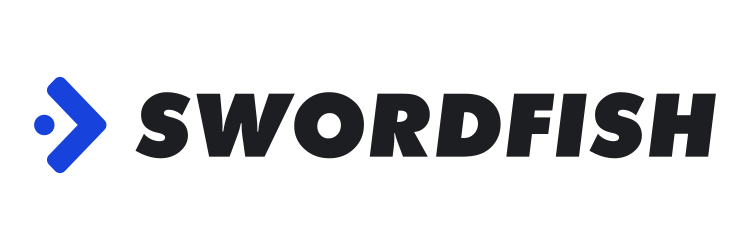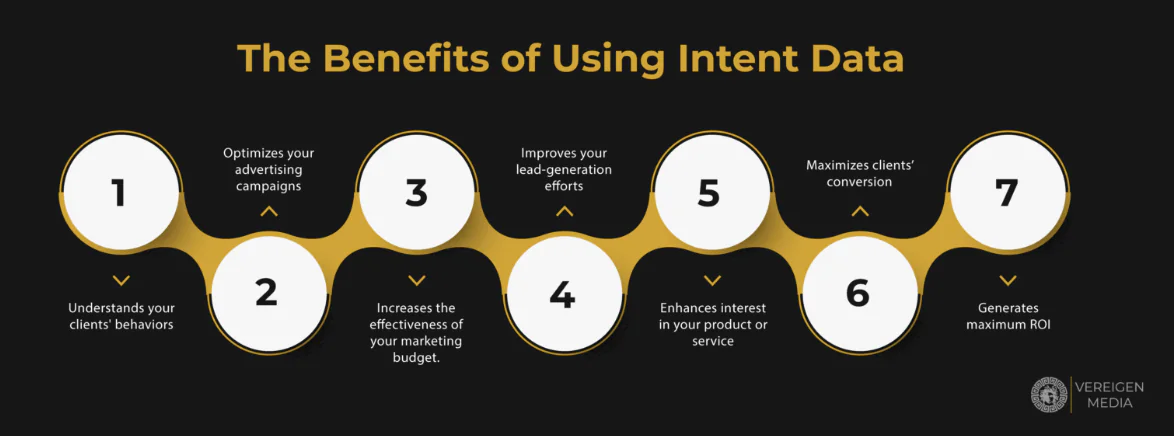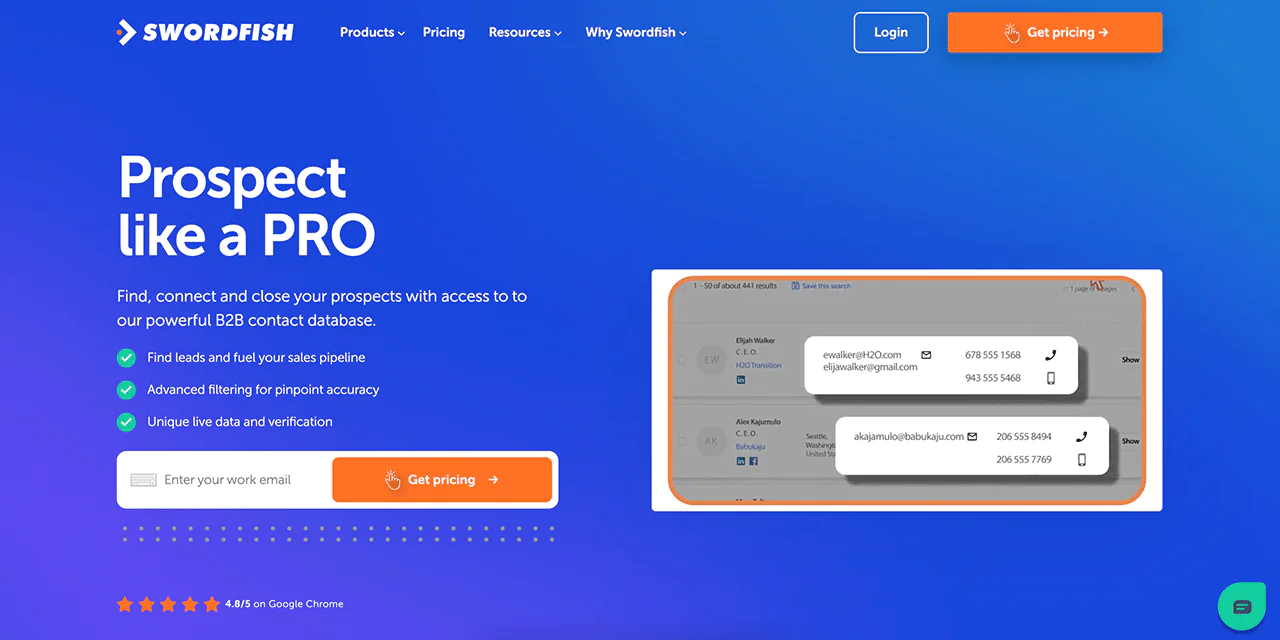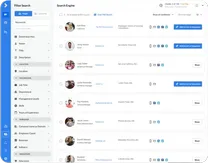Consumers worldwide are growing more reliant on online solutions for their pain points. They require a service that proactively helps them solve user-specific issues, and they need it faster than ever.
Client intent can reveal a wealth of information regarding their behavior and interests. You can reach out to them using the intent data to lead them through the stages of your sales funnel and convert them into paying customers.
Our blog answers the obvious question of “How to identify intent of a client?” and shows how you can harness client intent data to inform your marketing strategies to drive up conversion rates and ROI.
What Does Intent Data Say About A Client?
Client intent is understood as a particular client’s motivation for interacting with your business and undertaking the purchase journey. In the context of brick-and-mortar retail shops, a customer walking into the store and heading to the shirt aisle shows explicit buying intent.
In digital marketing, you must monitor minute details to identify client intent. Page visits, clicks, form submissions, etc., provide valuable insights and can help answer what a particular client is looking for by interacting with your business.
Client intent is gathered from their online behavior to understand their interests. Your company can utilize the data to create content relevant to a particular client’s needs and personalize your marketing strategies to move them through the sales funnel faster and encourage them to purchase.
Knowing your client’s intent and delivering a satisfactory experience is vital for building meaningful business relationships. An effective marketing strategy informed by accurate client intent data helps create successful campaigns and nurture brand loyalty.
Client data goes beyond showcasing the intent to buy. Clients can also contact your company to lodge complaints, get solutions to a problem they’re facing with your service, or get more information before they decide to purchase.
Why You Need Intent Data for Your Business
Before we answer “How to identify intent of a client?” Let’s look at the “Why” you need data on client intent. Monitoring and predicting client intent can help your business in the following ways:
- Identify sales-ready clients: Client intent data allows you to understand their requirements and expectations in real-time. You can better gauge when a lead is sales-ready and reach out to them with personalized marketing to convert them.
Waiting for clients to reach out to you through forms or other methods risks your clients looking elsewhere in the marketing for solutions, making it harder for your sales reps to inform their opinions.
Identifying leads ready to buy can help you and your reps reach out to prospective clients faster and provide them with relevant content to maintain their interest in your company so that they choose your service over the competitors.
- Effective follow-up strategies: With client intent data, you can retain clients for longer with follow-up strategies based on the client’s behavior on your landing page and third-party websites like G2.
By identifying the campaigns and services they click on, you can personalize your messages and guide them to related content like blogs, newsletters, etc., that holds their interest in your company for longer and reduces churn rates.
- Move clients through the sales funnel faster: Client intent data can inform you what your client is looking for, thus helping you focus your efforts on targeting them with specific solutions.
From gathering leads to upselling opportunities, client intent data can inform every stage of your sales funnel and make informed decisions.
- Increased client lifetime value (LTV): You want to foster brand loyalty in your clients so that they pay customers for a steady stream of revenue. The client lifetime value (LTV) increases your ROI by bringing revenue from an already converted lead.
By collecting intent data, you can actively monitor when your client is at risk of churning. Use the client intent data for re-engagement strategies to ensure inactive clients trust your solutions again and don’t look for other alternatives.
- Reduced customer acquisition cost (CAC): Similar to LTV, customer acquisition cost (CAC) is a factor to consider when calculating profits. A high CAC cuts into your overall ROI and leads to significant losses over time.
Targeting already converted clients with solutions based on their dynamic requirements can bring down the overall CAC and secure more profits.
- Optimize services and strategies based on feedback: Clients don’t interact with your business only to make purchases. As mentioned before, they can reach out to you to file complaints or gather more information to make a decision.
Information you acquire about clients can range from their emotion towards your company, showing appreciation, or leaving constructive criticism. Implementing updates based on consistent feedback ensures you win the client’s trust and make them feel heard.
How To Identify Intent of a Client
Client intent can benefit your marketing strategies significantly, so let’s discuss how to identify intent of a client to acquire vital insights.
Intent data can be divided into two types: observed data and inferred data.
Let’s break these terms down to understand them better:
- As the name suggests, observed data can be acquired by directly referring to the source and is generally accurate. On the other hand, inferred data is less accurate and has to be predicted.
Observed data can be gathered from data management platforms, CRMs, and other sales and marketing tools to inform your campaigns.
Let’s dive deeper into inferred data:
- For inferred data, the first solution is to identify the elements of a search query from search engines. Understanding natural language can be used by segmenting the search queries to identify the different verbs and nouns associated with the search.
Paying close attention to intent modifiers can inform what your client wants with your service. For example, “best” implies your client is looking for comparisons to make, and “buy” means your client is ready for purchase.
Create a list of intent modifiers to inform you how to modify and create new content to target your clients who show buying intent and want more information before converting.
Now that you know how to collect observed and inferred data, let’s take a look at some general tips in regards to gathering intent data:
- You can gather client intent data by following clients on online platforms like LinkedIn, Twitter, etc. Knowing what your clients discuss and express what they are looking for to make accurate predictions.
- Monitoring what your clients click on and the marketing channels informs you where to focus your efforts. Client intent data from advertisements show you precisely the solutions they seek.
- Digital marketing has evolved to use Intent Classification that automatically classifies client intent into “Purchase.” “Downgrade,” “Unsubscribe,” and “Demo Request.” Intent Classification uses ML and Natural Language Processing to associate words with a particular intent.
Intent data can be utilized with NLP to inform conversational AI chatbots to engage clients actively and provide recommendations for guides and content to drive more conversions.
Using Intent Data Throughout Your Sales Funnel
Now that I have answered, “How to identify intent of a client?” I will guide you through harnessing and incorporating the collected client data throughout your sales funnel.
When finding prospects for your sales funnel, client intent data can enhance your lists to include clients who match your ideal customer profile (ICP). You can target companies and clients better based on the prospect list.
With the prospect list, you can move clients forward in the sales funnel to engage them with high-quality content to convert more leads. Once a lead is converted, you can identify opportunities to cross-sell or upsell to increase the customer LTV.
Although the steps sound simple and laid out, finding prospects can become a lengthy process that cuts into the time you could have used to finalize more deals. Manually searching for prospects can become tedious for smaller organizations.
Trust Swordfish AI to optimize your sales strategies if you want a tool that automates your prospect-finding process with verified contacts worldwide,
Swordfish AI: The Ultimate Prospect Finder Tool
Swordfish AI is a robust and intuitive prospect finder tool that helps B2B business users close more deals by cutting down on the time it takes to find contacts of key decision-makers in the market and saving resources by providing verified prospects automatically.
You can acquire verified public information for effective outreach and engagement strategies like names, email addresses, residential addresses, social profiles, etc., for over 3.1 billion contacts. We collaborate with 200+ data partners to update our database in real time.
Contacts can be searched by inputting specific credentials or in bulk from platforms such as LinkedIn and Facebook. Our Chrome Extension feature lets you bypass the hassle of manual clicking to find prospects on online platforms and save them to various projects or lists.
Swordfish AI’s File Upload feature lets you append missing data in your CRM, ATS, and databases for names, job titles, locations, contact numbers, mobile numbers, business emails, etc., by uploading files in Excel, CSV, and other formats in our browser platform.

Reverse Search provides complete publicly available contact information for prospects by inputting only one credential allowing our service to fill in the remaining credentials automatically.
You can prioritize your data requirements by specifying “must-have” credentials like phone numbers or email addresses. We charge based on the responses we provide to must-have results. We don’t charge you if we fail to provide a match.
Swordfish AI introduces the Refresh Job Title + Company that saves you from failed email outreaches and cold calls by enriching your databases with updated information after you input the LinkedIn URL for the specific company.

Pricing

Swordfish AI offers custom pricing plans based on the requirements of every team in your company working on different parts of the sales pipeline. Our services seamlessly integrate into your workflows and CRM/ATS to readily provide verified prospects.
Your sales and marketing teams can benefit from Swordfish AI by using accurate client data to re-engage and follow up with clients with purchase intent to convert them into sales-ready leads successfully. You no longer have to waste time communicating with wrong or inactive contacts.
Contact us to test our features with a free trial, and talk to us about your personalized prospect requirements so we can provide you with the perfect package.
Conclusion
Knowing how to identify intent of a client is essential for a successful marketing campaign that converts prospects into sales-ready leads faster. Without intent data, you can risk making incorrect business decisions that can hurt your revenue significantly.
Swordfish AI can help kickstart your lead generation strategy by providing verified contacts for billions so you don’t waste time reaching out to inactive or wrong contacts and reach key decision makers faster.
Contact us to try our features risk-free with a free trial, and talk to us about a personalized pricing plan that covers your prospect-finding requirements. Revolutionize your lead generation strategy with Swordfish AI today!


 View Products
View Products





